Did you know that language models can engage in dynamic and interactive conversations? By chaining multiple prompts together, developers can create seamless & contextually rich dialogues with language models. This is where LangChainJS comes into play, offering a powerful solution for prompt chaining. With LangChainJS, you can elevate your language processing applications and deliver engaging user experiences. In this article, we will explore the art of chaining multiple prompts on LangChainJS, empowering you to unlock the full potential of seamless language processing. So let’s Goo! Before that, if you want to know more about how to convert a LangChain app from Open AI to open source you can read our blog here.
Well! First, let’s understand-
What is Prompt Chaining?
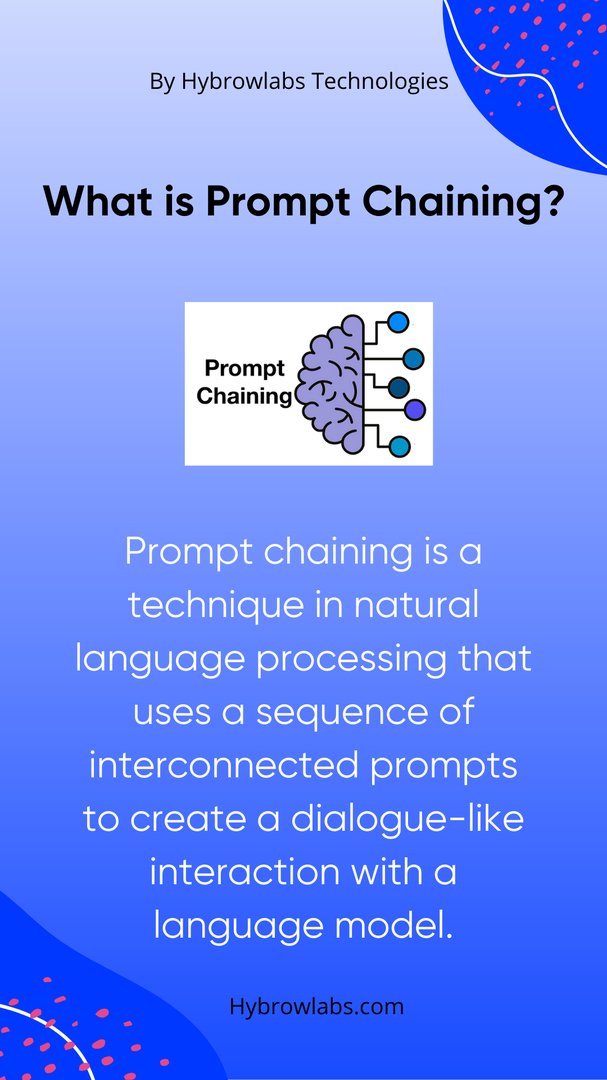
Prompt chaining is an approach in natural language processing that involves creating a sequence or chain of prompts to interact with a language model. In traditional language model usage, a single prompt generates a response. However, with prompt chaining, multiple prompts are used in a sequential manner to create a conversation-like flow with the language model.
In prompt chaining, each prompt in the chain builds upon the context & information provided by the previous prompts. This allows for a more coherent & contextually aware interaction with the language model. By extending the conversation through chaining, developers can simulate a dynamic dialogue & achieve more nuanced & accurate responses.
Developers typically use APIs or libraries provided by language model platforms like OpenAI API or LangChainJS to implement prompt chaining. These tools offer functionalities to create, manage & execute prompt chains, enabling the generation of responses beyond a single prompt input.
Prompt chaining can be used for a variety of NLP tasks, including:
- Answering questions
- Generating text
- Translating languages
- Performing natural language inference
What is OpenAI API?
OpenAI API is an application programming interface provided by OpenAI, a leading artificial intelligence research organization. It allows developers to access & utilize the power of state-of-the-art language models developed by OpenAI. An API, or Application Programming Interface, acts as a bridge between different software applications, enabling them to communicate & interact with each other.
The OpenAI API specifically focuses on language models, which are designed to understand & generate human-like text based on the input provided to them. By integrating the OpenAI API into their applications, developers can harness the capabilities of these language models without needing to build & train their own models from scratch.
The OpenAI API offers a range of functionalities, including text generation, question-answering, language translation, sentiment analysis & more. It allows developers to send requests to the API with specific instructions & receive generated text or other relevant information in response.
By leveraging the OpenAI API, developers can create a wide variety of applications that involve natural language processing. These applications can range from chatbots and virtual assistants to content generation tools, customer support systems, language translation services & more.
Understanding LangChain:
LangChain is a technique that takes advantage of the OpenAI API to chain multiple prompts together, simulating a conversation or dialogue. By sequentially feeding prompts to the language model, developers can create a contextually aware interaction. Each prompt in the chain builds upon the previous ones, resulting in a cohesive and flowing conversation with the language model.
To know more about LangChain & how LangChain can Revolutionizing Decision-Making read our full blog.
How Prompt Chaining Works?
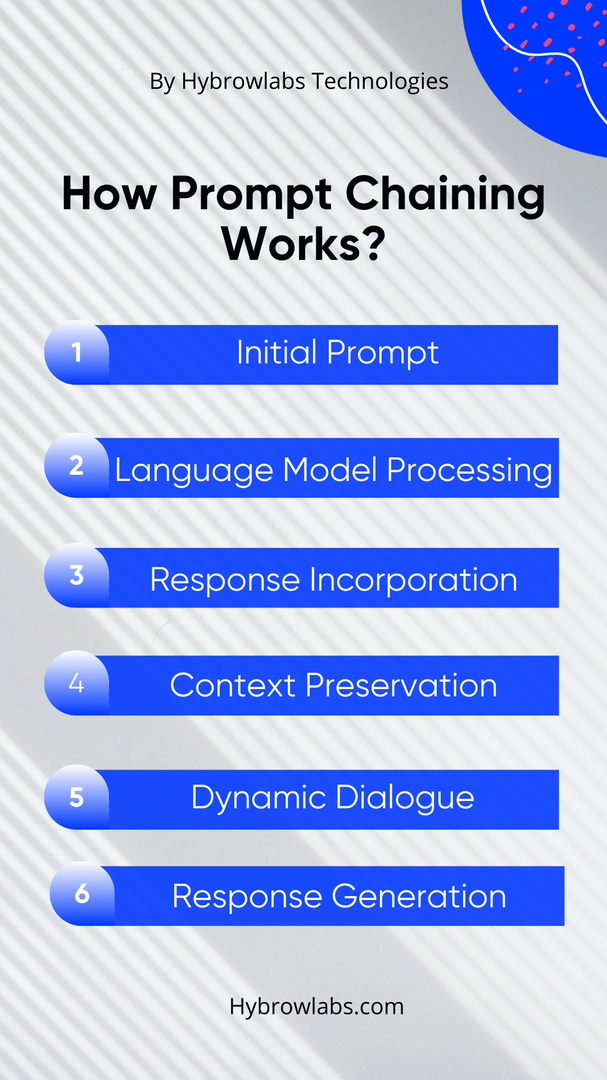
Prompt chaining works by sequentially feeding a series of prompts to a language model, creating a conversation-like flow & enabling contextually aware interactions. Here's an overview of how prompt chaining typically functions:
1. Initial Prompt:
The prompt chain begins with an initial prompt, which sets the context or initiates the conversation. This prompt can be a user query or statement.
2. Language Model Processing:
The language model processes the initial prompt & generates a response based on its understanding of the provided input.
3. Response Incorporation:
The generated response becomes part of the conversation context. It is then appended to the prompt chain as the next prompt, building upon the preceding prompts.
4. Iterative Process:
The prompt chain continues to expand iteratively. Each new prompt in the chain is based on the previous prompt's response, allowing for a natural conversation flow.
5. Context Preservation:
By incorporating previous prompts & responses, the language model maintains a contextual understanding of the conversation. This helps in generating coherent & relevant responses.
6. User Interaction:
Depending on the application's logic, user inputs or queries can be introduced into the prompt chain. These inputs are added as new prompts in the chain, further extending the conversation.
7. Dynamic Dialogue:
As the prompt chain grows, the conversation evolves, simulating a back-and-forth dialogue between the user & the language model. The language model considers the context provided by the entire prompt chain to generate contextually relevant replies.
8. Response Generation:
The final response is obtained by executing the prompt chain, typically through an API call to the language model service. The language model generates a response based on the accumulated context from the prompt chain.
What Are The Benefits Of Prompt Chaining?
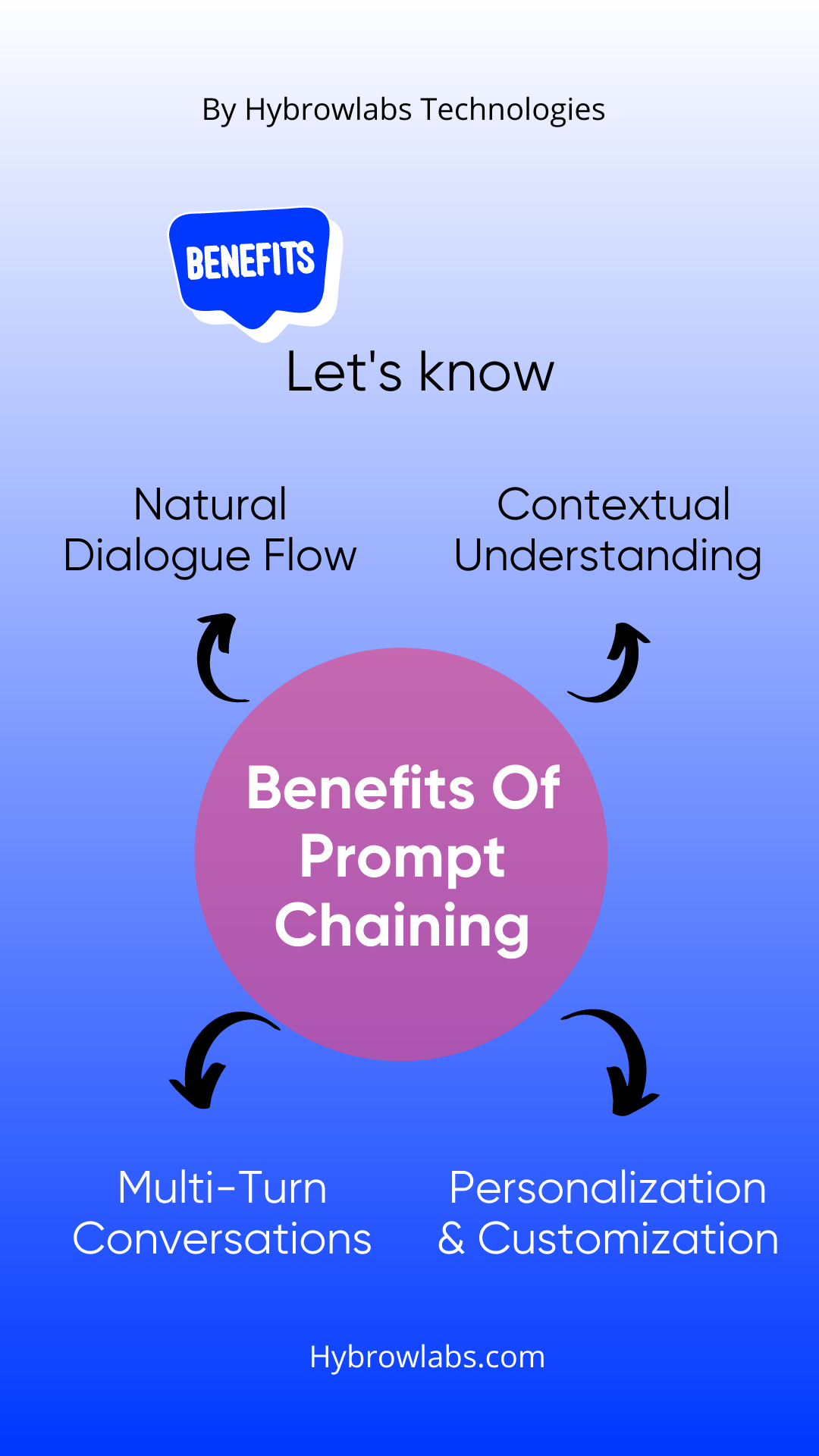
1. Contextual Understanding:
Chaining prompts enable language models to maintain context & understand the ongoing conversation. Each prompt builds upon the previous ones, allowing the model to capture the context & information provided earlier. This leads to more coherent & contextually relevant responses.
2. Natural Dialogue Flow:
Prompt chaining simulates a natural conversation flow, creating a more interactive & engaging experience for users. By structuring prompts in a sequential manner, the conversation becomes more dynamic & resembles a back-and-forth dialogue, making interactions with language models feel more human-like.
3. Personalization and Customization:
With prompt chaining, developers can tailor the conversation to specific user needs. By incorporating user inputs and dynamically modifying the prompt chain, it becomes possible to deliver personalized responses & cater to individual preferences.
4. Multi-Turn Conversations:
Prompt chaining allows for multi-turn conversations, where each prompt in the chain represents a different turn or phase of the dialogue. This enables more complex interactions & supports scenarios where users need to provide multiple inputs or engage in deeper discussions.
5. Improved Coherence and Relevance:
Chaining prompts help mitigate the issue of generating disconnected or unrelated responses. By considering the context from previous prompts, the language model can generate more coherent & contextually appropriate replies, ensuring that the generated text aligns with the conversation flow.
Step-By-Step Process of Chaining Multiple Prompts:
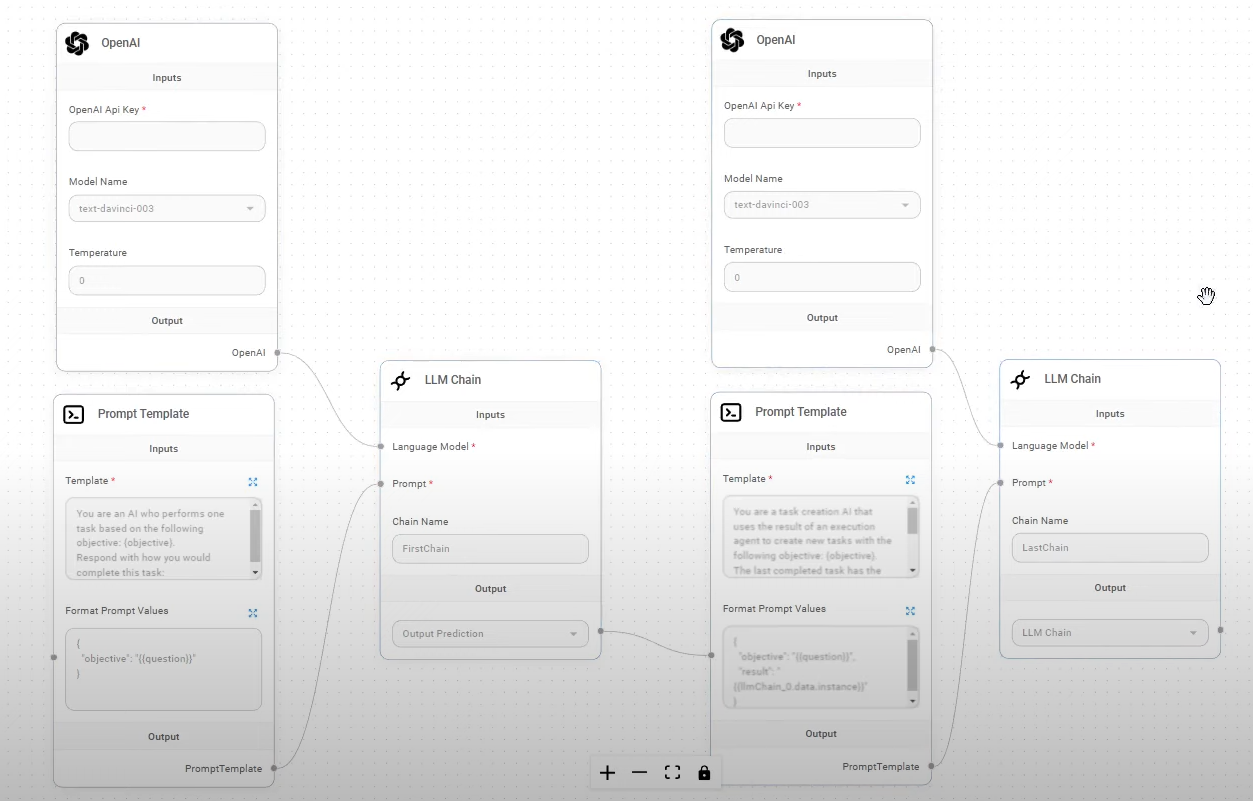
Chaining multiple prompts is a powerful technique that allows you to combine the output of multiple language models to create more complex & sophisticated outputs. This can be used for a variety of tasks, such as generating creative text formats, answering your questions in an informative way & translating languages.
To chain multiple prompts on LangChainJS, you need to follow these steps:
1. Create a prompt template:
This is a string that contains the text of the prompt, along with any variables that you want to be replaced with the output of the previous chain. For example, the following prompt template would ask the AI to write a poem about a cat & the variable {name} would be replaced with the name of the cat:
Write a poem about a cat. The cat's name is {name} and it is {color}.
2. Create a prompt chain:
This is an object that specifies the prompt template, the language model that you want to use & any other parameters that you want to pass to the language model. For example, the following code would create a prompt chain that uses the GPT-3 language model to generate a poem about a cat:
const promptChain = new LLMChain({prompt: prompt_template,llm: "gpt-3",});
3. Combine multiple chains:
If you want to chain multiple prompts together, you can use the SimpleSequentialChain class. This class takes a list of prompt chains as input, and it runs them one after the other. For example, the following code would chain two prompt chains together:
const chain1 = new LLMChain({prompt: prompt_template1,llm: "gpt-3",});const chain2 = new LLMChain({prompt: prompt_template2,llm: "gpt-3",});const combinedChain = new SimpleSequentialChain([chain1, chain2]);
4. Run the chain:
Once you have created a prompt chain, you can run it by calling the run() method. This method will return the output of the language model, which can be a string, a list of strings, or an object. For example, the following code would run the combined chain that we created in the previous step, & it would print the output of the language model:
const output = combinedChain.run();console.log(output);
Chaining multiple prompts can be a powerful tool for unlocking seamless language processing. By combining the output of multiple language models, you can create more complex & sophisticated outputs that would not be possible with a single model. This can be used for a variety of tasks, such as generating creative text formats, answering your questions in an informative way & translating languages.
Conclusion:
With LangChainJS, you can unlock the ability to simulate human-like conversations, creating chatbots, virtual assistants & other language-driven applications that engage & delight users. The power of prompt chaining lies in its ability to go beyond single prompts, providing a seamless flow of dialogue that mimics real-world conversations. Are you looking for help in Chaining Multiple Prompts on LangChainJS? Partner with Hybrowlabs, specialized in natural language processing (NLP) and has expertise in working with different language language models. To know more about our services Contact us.
FAQ:
1. What is prompt chaining?
Prompt chaining is an approach that involves linking multiple prompts together in a sequential manner to simulate a conversation with a language model. It allows for a more interactive & contextually aware interaction.
2. How does prompt chaining enhance language processing?
Prompt chaining enhances language processing by providing a conversational flow, maintaining context & enabling dynamic interactions with language models. It leads to more coherent, relevant & engaging responses.
3. Can I chain prompts with different templates or structures?
Yes, you can chain prompts with different templates or structures. Each prompt in the chain can have its own template, allowing for flexibility in shaping the conversation.
4. Why should I use LangChainJS for language processing?
LangChainJS simplifies complex language processing tasks by allowing you to chain together multiple prompts. Instead of creating large, unwieldy prompts for each task, you can break down the process into manageable prompts and combine them using LangChainJS.
5. How do I install LangChainJS?
LangChainJS can be installed using npm with the command ‘npm install langchainjs’. After installation, you can import it into your JavaScript project using the standard import syntax.



.png)


a3dc85.jpg)

.jpg)
fd8f11.png)
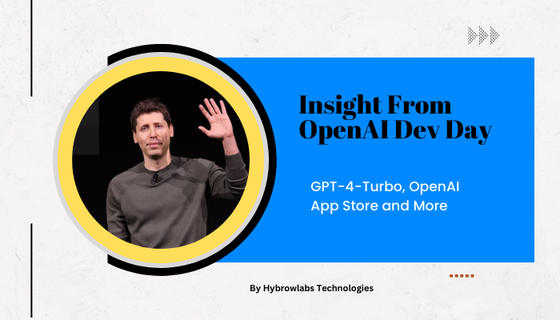
.jpg)
.jpg)